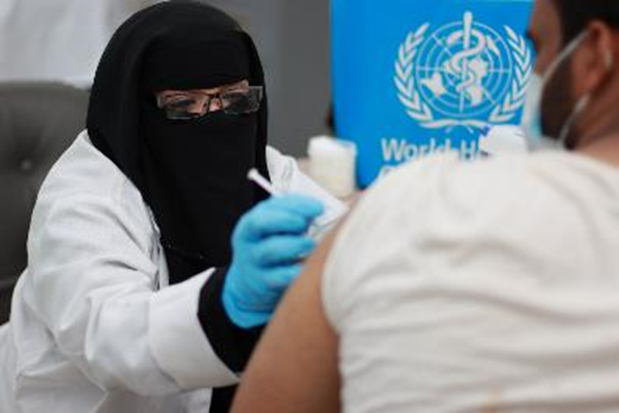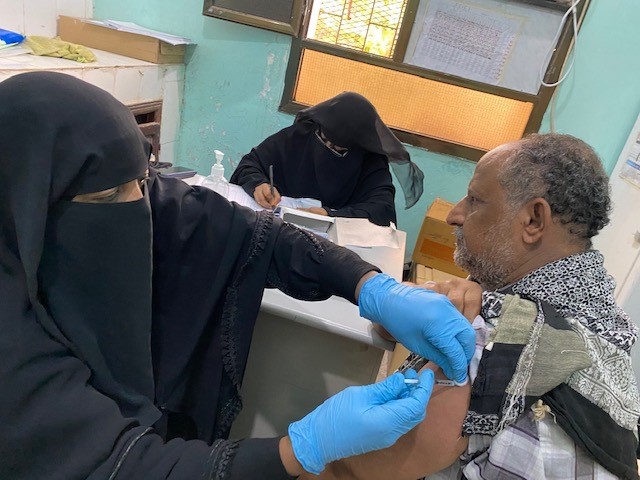 Aden, 31 August 2022 – For the past 13 years, Yemen has ranked last in the World Economic Forum’s Global Gender Gap Index. Where women lack access to participate in health, education, the economy and politics, societies and future generations suffer. That’s why achieving a basic level of participation of women in the workforce against COVID-19 was a key result indicator in the design of the Yemen COVID-19 Response Project implemented by WHO and the World Bank.
Aden, 31 August 2022 – For the past 13 years, Yemen has ranked last in the World Economic Forum’s Global Gender Gap Index. Where women lack access to participate in health, education, the economy and politics, societies and future generations suffer. That’s why achieving a basic level of participation of women in the workforce against COVID-19 was a key result indicator in the design of the Yemen COVID-19 Response Project implemented by WHO and the World Bank.
Dr Adham Rashad Ismail Abdel Moneim, the WHO Representative to Yemen explains, “The Yemen COVID-19 Response Project Results Framework included a target of females accounting for one in three COVID-19 vaccinators. One year later however, women make up more than half the COVID-19 vaccination workforce.”
Several key enablers of success contributed to this target being so dramatically exceeded.
First, the partnership between the Bank and WHO on the Yemen COVID-19 Response Project from April 2020 onwards, built on the foundations of the Emergency Health and Nutrition Project since 2017, in which gender-responsive and gender-sensitive programming was integral to the project management approach.
 Meaningful consultations with female health workers and community members, and awareness sessions on gender, were built into the Emergency Health and Nutrition Project design, done routinely, and reported on every 6 months. This helped to sensitize the parties involved and built acceptance at the outset of the Yemen COVID-19 Response Project, of the need for gender-sensitive services to better meet the needs of Yemeni women and the wider community.
Meaningful consultations with female health workers and community members, and awareness sessions on gender, were built into the Emergency Health and Nutrition Project design, done routinely, and reported on every 6 months. This helped to sensitize the parties involved and built acceptance at the outset of the Yemen COVID-19 Response Project, of the need for gender-sensitive services to better meet the needs of Yemeni women and the wider community.
Advocacy with the health authorities in the design of Yemen COVID-19 Response Project and in the development of the project operational plan helped to draw attention to the importance of increasing the participation of women in the health workforce. This included a gender-sensitive model being used in the development of the COVID-19 vaccination plan. In this way, the project successfully implemented top-down approaches and involved managers to reduce gender discrimination and build a stronger workforce.
Throughout the project’s implementation, this advocacy continued, along with continued engagement and consultation with female health workers and beneficiaries, and awareness sessions for all health workers on environmental and social safeguards. The Yemen COVID-19 Response Project project team also made regular requests for, and investments in, sex-disaggregated data both on vaccinators and people receiving vaccination. The availability of female vaccinators was closely monitored by WHO, in line with the Results Framework, and coupled with political will at the outset to recruit more female vaccinators in order to ensure the target was achieved.
It was hoped, and advocated for, that having more female vaccinators, would lead to higher levels of vaccination uptake among women. However, the data so far indicate that for every 3 men, only one woman, has received a COVID-19 vaccine. Noting that while recruitment of female vaccinators is within the scope of the health sector, assuring vaccine demand requires all-of-society action. Additional factors include that international travel may have been a key motivator for vaccination, and most travellers out of Yemen are men. In some governorates, there are restrictions on women travelling alone and men take decisions as to when and why women should seek health care, which may also have limited female access to vaccination sites.


